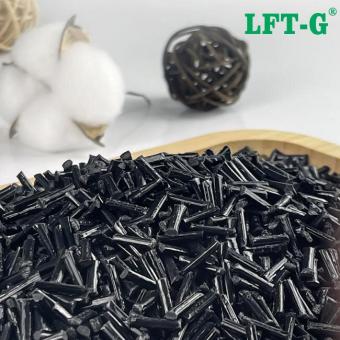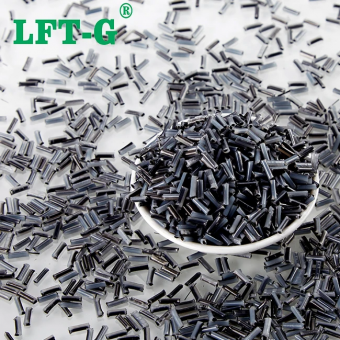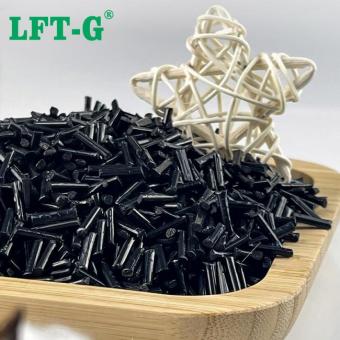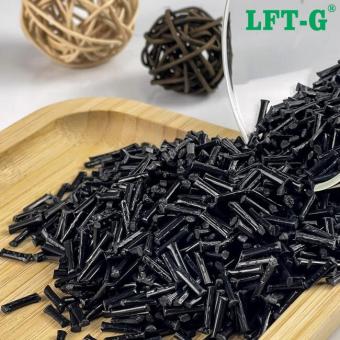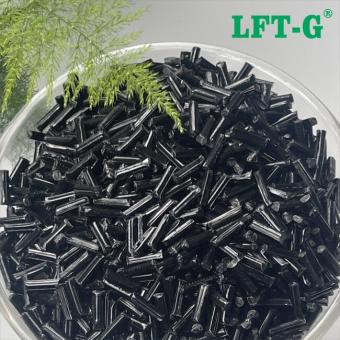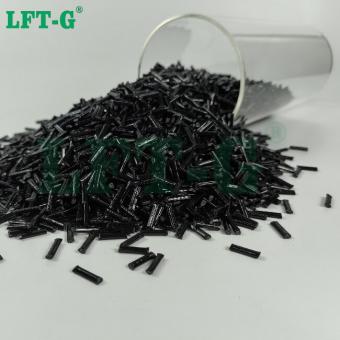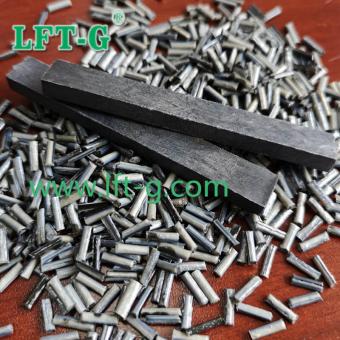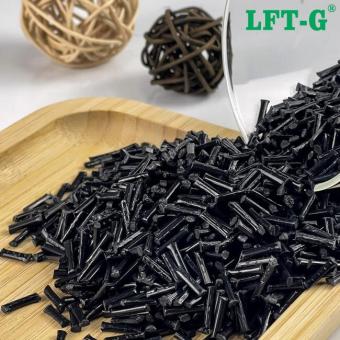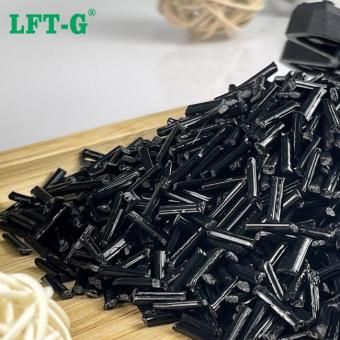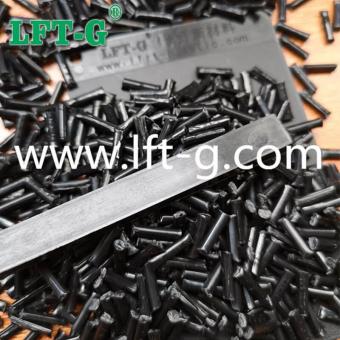A fibra de carbono longa é um novo material com alta resistência e alto módulo e excelentes propriedades mecânicas. é um material de grafite microcristalina obtido por carbonização e grafitização de fibras orgânicas. sua gravidade específica é menor que 1/4 de aço e sua resistência é maior que a do aço. resistente à corrosão, alto módulo, sem fusão. e uma variedade de substratos de resina após a moldagem por extrusão de impregnação em pelotas, polímero de fibra de carbono longo. pode ser usado para produtos de moldagem direta. nos últimos anos, tem sido amplamente utilizado em produtos químicos aeroespaciais, mecânicos e eletrônicos.
-
China Fabricante PEEK Pelotas Longas Reforçadas com Fibra de CarbonoO próprio PEEK puro é um plástico de engenharia especial, com resistência à radiaç、o, autolubrificaç、o, resistência a altas temperaturas, resistência ao desgaste, resistência à fadiga e outras características. O desempenho do material PEEK reforçado com fibra de carbono melhorou em muitos aspectos em comparaç、o com o material PEEK puro. O material composto reforçado com fibra de carbono longa PEEK é 5 vezes mais forte que o metal, 60% mais leve e mais de 10% melhor que produtos similares .
- Fornecedor de materiais PEEK
- plástico polímero termoplástico PEEK
- Venda de fábrica de poliéter éter cetona
- Pelotas cheias de carbono PEEK
- Moldagem por injeção espia cor preta
- Propriedades PEEK de alta resistência
Tags :
-
Compostos longos reforçados com fibra de carbono de poliamida 12 de nylon LFTO material reforçado com fibra de carbono longa PA12 combina as excelentes propriedades da poliamida 12 com a resistência e rigidez das fibras de carbono longas. Este compósito de alto desempenho oferece resistência mecânica superior, resistência ao impacto e estabilidade dimensional, tornando-o ideal para aplicações exigentes nos setores automotivo, aeroespacial e industrial.
- Fornecedor de fibra de carbono longa PA12
- Impressão 3D composta PA12 automotiva
- Resina termoplástica fabricada na China
- Pelotas de resina de polímero de filamento pA66
- EDM atacado em estoque de materiais PA 12
- Melhor preço PA12 de alta resistência
Tags :
-
Compostos longos reforçados com fibra de carbono de poliamida 66 de nylon LFTPA66-CF40 é um PA 66 reforçado com 40% de fibra de carbono longa, oferecendo resistência excepcional, resistência à fluência, rigidez e estabilidade dimensional. Após a modificação, o PA66-CF40 apresenta excelentes propriedades mecânicas, tornando-o altamente resiliente e ideal para aplicações de alta carga em ambientes de temperaturas extremas. Este material é particularmente adequado para componentes que exigem alta resistência e durabilidade por longos períodos, como capas e peças estruturais em máquinas e veículos.
- PA66 Enchimento PA CFRP 40 30 20
- aplicação polimaker pa66-cf30
- EDM atacado em estoque de materiais PA 66
- Melhor preço PA66 de alta resistência
Tags :
-
Compostos longos de enchimento reforçados com fibra de carbono de poliamida 6 de nylonOs compostos longos de fibra de carbono PA6 oferecem resistência, rigidez e baixo peso excepcionais, tornando-os ideais para aplicações de alto desempenho em setores como automotivo, aeroespacial e eletrônico. Esses materiais fornecem propriedades mecânicas superiores, incluindo alta resistência à tração e excelente resistência à fadiga, ao mesmo tempo que garantem maior estabilidade dimensional sob condições extremas. Os compósitos longos de fibra de carbono PA6 são uma solução confiável para substituir metais em componentes estruturais leves e exigentes.
- PA6 PA enchimento CFRP 40 30
- aplicação polimaker pa6-cf30
- Filamento de fibra de carbono pA6
- Venda por atacado de EDM em estoque de materiais PA6
- Melhor preço PA6 de alta resistência
Tags :
-
Polipropileno homopolímero que enche o polímero longo da fibra do carbono para automotivoCompostos de fibra de carbono longa PP homopolímero oferecem excelentes propriedades mecânicas, incluindo alta resistência, rigidez e resistência ao impacto. Esses materiais são ideais para aplicações de alto desempenho nos setores automotivo, aeroespacial e industrial, onde soluções leves, porém duráveis, são essenciais. Com estabilidade dimensional e resistência térmica superiores, os compósitos de fibra de carbono longa PP homopolímero fornecem uma alternativa confiável aos metais em ambientes exigentes.
- Fibra de carbono de alta tenacidade pp
- Fabricação de resina de polipropileno na China
- filamento de fibra de carbono pp CF CFRP
- Venda por atacado de EDM em materiais PP em estoque
- Melhor preço PP de alta resistência
Tags :
-
Fibra longa extra do carbono do polipropileno do copolímero de grande resistência enchidaO polipropileno reforçado com fibra de carbono longa (PP) combina os benefícios das fibras longas de carbono e a flexibilidade dos copolímeros PP, oferecendo resistência, rigidez e resistência ao impacto excepcionais. É ideal para aplicações exigentes em indústrias como automotiva, eletrônica e aeroespacial, onde alto desempenho mecânico e baixo peso são essenciais. Este material oferece estabilidade dimensional superior, resistência ao calor e maior resistência à fadiga e ao desgaste.
- fibra de carbono pp
- CFRP reciclado Leve em vez de metal
- pp reforçado com fibra de carbono
- peças impressas em 3D de fibra de carbono
- Melhor preço PP de alta resistência
Tags :
-
Composto PEEK reforçado com fibra de carbono UltraStrong – material de engenharia de alto desempenhoOs materiais compósitos PEEK reforçados com fibra de carbono combinam as propriedades de alto desempenho do PEEK com a resistência e durabilidade da fibra de carbono, tornando-os ideais para aplicações em ambientes extremos e impressão 3D.
- Plástico de alta temperatura
- Materiais Compostos PEEK
- PEEK reforçado com fibra de carbono
- Plásticos de alto desempenho
- Impressão 3D PEEK
- Aplicações de materiais PEEK
Tags :
-
Polipropileno homopolímero (PP) reforçado com fibra de carbono longa LFT-G™ Premium para aplicações de alto desempenhoNosso PP de fibra de carbono longa é um composto de polipropileno de alto desempenho, projetado para oferecer resistência excepcional e propriedades de leveza, tornando-o ideal para aplicações exigentes, como peças automotivas.
- Materiais Compostos PP
- PP de fibra de carbono para automotivo
- Plástico leve de fibra de carbono
- Fibra de Carbono Longa PP
- Polipropileno Reforçado com Fibra de Carbono
- Polipropileno de alto desempenho
Tags :
-
Composto PEEK reforçado com fibra de carbono UltraStrong – material de engenharia de alto desempenhoOs materiais compósitos PEEK reforçados com fibra de carbono combinam as propriedades de alto desempenho do PEEK com a resistência e durabilidade da fibra de carbono, tornando-os ideais para aplicações em ambientes extremos e impressão 3D.Veja mais
-
LFT Nylon Poliamida 12 Fabricante Compostos preenchidos com fibra de carbono plástico de engenharia especialSe você não tiver certeza de qual material PA é adequado para você, informe-nos suas necessidades e nossa equipe fornecerá suporte técnico gratuito.
- Material termoplástico reforçado com resina PA 12
- polímero de enchimento de fibra em vez de aço metálico
- Amostra grátis de plástico natural novo CFRP
- peças estruturais plásticas de engenharia
- resina modificada bom preço baixo MOQ
- pára-lamas automotivos resistentes ao desgaste flexíveis
Tags :
-
Xiamen LFT-G Poliamida 66 Longa Fibra de Carbono com resistência ao desgaste para peças automotivasPropriedades físicas de materiais de náilon Excelentes propriedades mecânicas: alta resistência mecânica, boa tenacidade. Excelente autoumedecimento, resistência ao desgaste: pequeno coeficiente de atrito, longa vida útil como componente de transmissão. Excelente resistência ao calor: a temperatura de distorção de calor PA66 é muito alta, pode ser usada por um longo tempo a 150 graus Celsius, PA66 após reforço de fibra de vidro, a temperatura de distorção de calor de 252 graus Celsius ou mais. Excelentes propriedades de isolamento elétrico: sua resistência ao volume é muito alta, alta resistência à tensão de ruptura, é um excelente material de isolamento elétrico/eletrônico. Introdução de pellets LCF preenchidos com Nylon66 PA66 é um plástico de engenharia de alto desempenho, absorção de umidade, baixa estabilidade dimensional de produtos, resistência e dureza e metal. Para superar essas deficiências, já na década de 1970, as pessoas usavam fibra de carbono e fibra de vidro para melhorar seu desempenho. PA66 reforçado com materiais de fibra de carbono nos últimos anos o desenvolvimento mais rápido, porque PA66 e fibra de carbono são excelente desempenho no campo de materiais plásticos de engenharia, o material compósito incorporação abrangente da superioridade dos dois, como resistência e rigidez do que o PA66 não aprimorado é muito maior do que a da fluência em alta temperatura é pequena, a estabilidade térmica de uma melhoria significativa na precisão dimensional do bom, resistente ao desgaste. Atualmente, os materiais compósitos de fibra de carbono PA66 são principalmente partículas reforçadas com fibra de carbono curta ou longa, têm sido amplamente utilizados na indústria automotiva, artigos esportivos, máquinas têxteis, materiais aeroespaciais e outros campos. A fibra de carbono é leve, tem alta resistência à tração, resistência à abrasão, resistência à corrosão, resistência à fluência, condutividade elétrica, transferência de calor, etc. É muito semelhante à fibra de vidro, mas superior à fibra de vidro. Comparado com a fibra de vidro, o módulo é 3 vezes maior, que é um material com alta rigidez e alta resistência. Folha de dados do PA6-LCF para referência A partir dos experimentos do departamento técnico, sabemos que a resistência à flexão, o módulo de elasticidade à flexão, a resistência ao impacto e a resistência ao cisalhamento plano do material adicionado de fibra de fibra de carbono PA66 aumentam com o aumento do teor de fibra de carbono, resistência ao cisalhamento transversal diminuiu ligeiramente, em geral a resistência do material aumentou dramaticamente. Aplicação de PA66-LCF Certificado Certificação do Sistema de Gestão da Qualidade ISO9001/16949 Certificado de Acreditação de Laboratório Nacional Empresa de Inovação em Plásticos Modificados Certificado Honorário Testes REACH e ROHS de metais pesados Fábrica e Laboratório Perguntas e Respostas 1. Existem dados de referência unificados para o desempenho dos produtos de fibra de carbono? O desempenho de filamentos de fibra de carbono específicos é fixo, como os filamentos de fibra de carbono da Toray, T300, T300J, T400, T700 e assim por diante, há uma série de parâmetros que podem ser rastreados. No entanto, não existe um padrão uniforme para medir os produtos compostos de fibra de carbono. Em primeiro lugar, os diferentes tipos de matérias-primas selecionadas levarão a diferentes desempenhos dos produtos e, em seguida, devido à escolha da matriz e ao design diferente dos produtos, conduzirão a diferentes desempenhos dos produtos. Além de alguns tubos comuns de fibra de carbono, placas de fibra de carbono e outras peças convencionais, a maioria dos produtos de fibra de carbono na produção da amostra antes do teste para determinar se o desempenho do produto está em linha com o uso do padrão esperado , e como ponto de base, para realizar a produção e utilização de grandes quantidades. 2. Os produtos compostos de fibra de carbono são caros? O preço dos produtos compósitos de fibra de carbono está intimamente relacionado ao preço das matérias-primas, ao nível de tecnologia e à quantidade de produtos. Alguns produtos dos requisitos do ambiente industrial são elevados, o desempenho dos produtos e materiais de fibra de carbono tem requisitos especiais, o que requer a seleção de matérias-primas específicas, matérias-primas, quanto maior o desempenho do preço natural do mais caro, como o aplicação de materiais termoplásticos ortopédicos de fibra de carbono PEEK. É claro que quanto mais complexo o processo de produção, maior será o tempo e a carga de trabalho, e o custo de produção aumentará. No entanto, quanto maior a quantidade encomendada, menor será o custo por peça, uma vez estabelecida a produção em massa de um determinado produto de fibra de carbono. No longo prazo, o desempenho superior da fibra de carbono prolongará a vida útil do produto, reduzirá o número de manutenções e também será muito benéfico para a redução do custo de uso. 3. Os produ...
- Matérias-primas plásticas PA66 moldadas por injeção
- Pelotas puras recicladas PA66 leves
- fibra de carbono longa pa66 cor preta natural
- grânulos pa66 lcf em vez de polímeros metálicos
- Aparelho eletrônico de baixo empenamento
- peças automotivas e aeroespaciais
Tags :

 o email
o email português
português English
English français
français Deutsch
Deutsch русский
русский italiano
italiano español
español العربية
العربية 日本語
日本語 한국의
한국의 中文
中文












